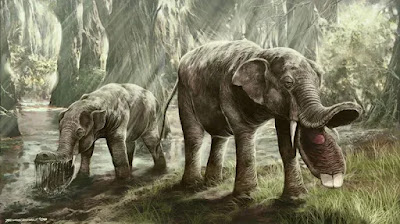Ok. So the wife picked up this thing on impulse:
Apparently it's a plushy called a Squishmallow. And although the character tag claims that this particular plushy (reportedly named "Mila") is an elephant wearing a beaver costume, we of the adventuring community know the truth.
This is yet another unholy chimera, redolent of the owl-bear.
Do not let Big Plushy lie to you.
The Beave-phant:
Denizens of the meandering savannah rivers, the beave-phant is a dwarf pachyderm hybridized with a beaver by someone who thought it was a good idea.
HD: 4-6; AC 5/14; Atk: Trunk toss and tail slap (2x 1d6+concussion) or trample (2d8); Move 120’ (40’) (on land or swim); Saving Throws D12 W13 P14 B15 S16 (3); Morale 8; Alignment Neutral; Number Appearing 1d4+2; Special: Concussion - save vs paralysis or be knocked unconscious 2d4 rounds. Drowning potential if victim lands in water.
Ancestor-elephant tusks have been substituted with large chewing teeth, which the creatures use to fell trees for construction of their dams and massive lodges. After felling the tree, the beave-phant will drag it to the waterway, manipulating the log with its trunk. The logs are then stacked and woven together and wattled with excavated mud to build their structures. The dams can block rivers, create lakes, and redirect waterways. Additionally, the beave-phants will excavate into the riverbed to create underwater accessways into their lodges. Where an infestation of beave-phants occurs, they can significantly impact river navigation, canal integrity, and riverside communities and agriculture.
Beave-phants live in small family groups, with a matriarch accompanied by one to two generations of her offspring. The females tend to have a retiring nature, and only act in defense of their family pods or lodges.
Bachelor herds comprised of semi-aquatic, non lodge-building males migrate between water bodies, seeking mates and sparring with one another for territorial dominance. The males have been known to wreak havoc on crops, as well as excavating furrows through saturated ground during their foraging. The males tend to be overtly aggressive, confronting intruders into their territory, whether beave-phant, other large herbivore, or humanoid. The males will often occupy ponds and lodges abandoned by matriarchal groups or other beave-phant.
Abandoned lodges find other semi-aquatic occupants, including the lizard-folk, who may share the environment with the beave-phants. Beave-phants tend to be wary if not defensive towards lizardfolk, as the latter have been known to hunt beave-phant. If a matriarch or male recognizes lizardfolk who have hunted their kin, they will attack on sight, with no quarter.
While these aquatic pachyderm-hybrids don't have the valuable tusks of their uncorrupted kin, the heavy chewing teeth can fetch a good price with some ivory collectors (1d6x50gp per tooth).
 |
| Not a Beave-phant, but a Platybelodon. Because Nature is more random than I am. |


My daughter loves Squishmallows. After this post I will now forever view them with different eyes...
ReplyDeleteDo not look upon it as innocence lost, but as knowledge gained. Forever vigilant! :)
DeleteHaha
Delete